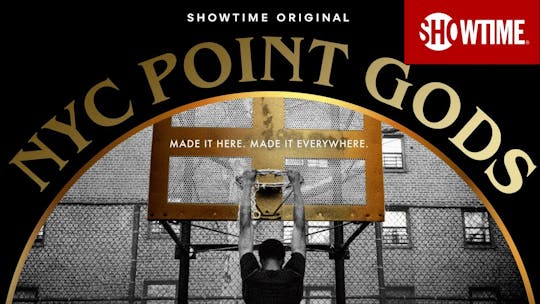Cam’ron, a New York rapper, is talking about one of his best friends who used to wear “orthopedic shoes” everywhere he went for a couple of months.
They ridiculed him, of course, Cam’ron recalls. But after three months, Cam’ron’s buddy began dunking on people. It had to be the shoes. At that point in his storytelling, the production crew throws him a pair of those exact jumping shoes to legit check, to which Cam’ron ecstatically confirms. Those were the shoes that his childhood friend wore in New York streets back then. That childhood friend is God Shammgod.
This is just one of the stories that NYC Point Gods, a documentary executively produced by Kevin Durant and Rich Kleiman, unearths from the people who were actually there at the height of it all. At some point in the timeline, the point gods of New York City were just starting out as point guards looking to put on a show. We’re brought back to this time in NYC Point Gods, both through first-hand accounts and blurry, pre-YouTube clips.
Showmanship and toughness are two traits invoked multiple times in the hour-and-a-half documentary, which served less as a love letter to the point guards of New York basketball, and more a long overdue greatest hits album, with bonus trivia behind each track.
The names in NYC Point Gods are exactly the ones you’d expect–from Rafer Alston to Kenny Anderson to Stephon Marbury to the aforementioned Shammgod. The film made a valiant attempt at covering every bit of real estate that comes to mind when talking about New York handles. Instead of a structured, historic timeline on how these point guards took over the city, NYC Point Gods focused on the names, cleared out, and let them cook–as they would on the court. They’re the frontmen running the show.
The first minute and a half of the film sets the tone. With artist Joekenneth Museau supplying poetry disguised as narration, NYC Point Gods was sure to establish immediately that this is the story of New York point guards told in the most New York way possible. This is not your standard issue documentary with talking heads. The speaking parts exclusively belonged to a who’s who of not only icons deeply connected to New York culture–the likes of Bobbito Garcia, Fat Joe, Chuck D, and Cam’ron–but those with big influences on the game, such as Stephen A. Smith and Rick Pitino.
But the appeal of the film is in its title and the participation of these actual point gods in the stories told and the moments revisited. NYC Point Gods would dedicate a bulk of its precious TRT on unpacking the Shammgod–how it was conceived by the creator himself and the aftermath on ball-handlers across the globe; on Alston’s AND1 roots and his unprecedented transition from streetball to the NBA; and on a singular, earth-shattering move by Anderson on a poor Bobby Hurley.
In probably one of KD and Kleiman’s board rooms, the business decision was made not to produce NYC Point Gods as an eight-episode series, which–depending on which side of the New York fence you’re on–was the correct call. The film, through its deep (and expensive) library of streetball, college ball, and NBA footage, was able to download the many nuances and iterations of what an NYC point god looks like. It spans a long history of fresh ball-handling and brash showmanship. This is the brand of New York basketball that NYC Point Gods gets accurately.
Like the Shammgod (the move, not the person), the film hits you with a quick magic trick that would make you want to hit pause, rewind, and relive again. As for the point gods themselves, the stories they tell here are the ones immortalized by whatever it is that defined basketball and hip-hop in the greatest city in the world. They were able to successfully create a world where the very concept of New York basketball is immortal–as gods do.




